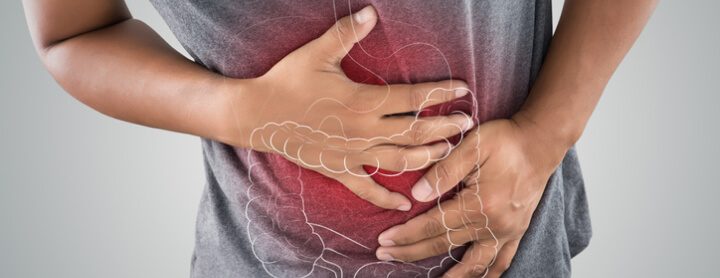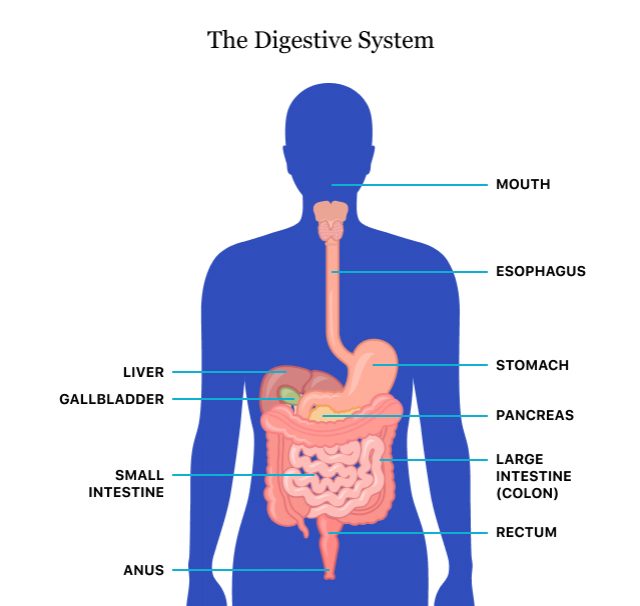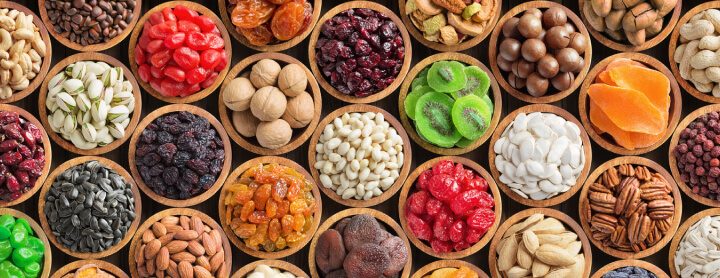Digestive Health
Good digestive health allows the body to properly break down food and absorb nutrients to keep the body healthy. People with healthy digestion are less likely to experience problems such as constipation, heartburn, bloating, indigestion or more serious digestive diseases. Common digestive diseases include acid reflux, gallstones and irritable bowel syndrome, or IBS.

Each part of the digestive system plays a role in breaking down food into smaller pieces and moving it through the body. The main parts of the digestive system are the gastrointestinal tract (GI tract), liver, gallbladder and pancreas. The parts of the GI tract are the mouth, esophagus, stomach, small and large intestine and the anus.
Gut flora, or the microbiota, is the bacteria in the GI tract. Gut health refers to the balance of these microorganisms that also help digest food.

Digestion of food or drink starts at the mouth. The muscles in the esophagus push the food down to the lower esophageal sphincter, a ring of muscle that separates the esophagus from the stomach. The sphincter opens to let food into the stomach, and the stomach mixes it with digestive juices and acid. The stomach pushes the mixture into the small intestine.
In the small intestine, nutrients are absorbed from food with the help of digestive juices from the pancreas, liver and gallbladder. Water and nutrients enter the bloodstream. Undigested food and waste products enter the large intestine. The large intestine removes any excess water from the waste products and turns it into stool.
| 2.5 to 3 hours | half of stomach contents emptied into small intestine |
| 4 to 5 hours | Stomach finishes emptying |
| 2.5 to 3 hours | About half of small intestine contents emptied into large intestine |
| 30 to 40 hours | Food finishes passing through the large intestine (colon) to the rectum |

Why Is Digestive Health Important?
Digestive health is important because without a healthy digestive system, the body cannot properly break down and absorb nutrients from food. Nutrients like amino acids from proteins, fatty acids from fats and simple sugars from carbohydrates provide energy and materials for growth and cell repair.
In addition, a healthy microbiome in the gut — bacteria in the stomach and intestines — is linked to overall good health and the prevention of health problems.
“We now know that the GI tract is full of trillions of bacteria that not only help us process food but that also help our bodies maintain homeostasis and overall well-being,” Dr. Tara Menon, a gastroenterologist at the Ohio State University Wexner Medical Center, told Time magazine.
When a person has a healthy gut, good bacteria and bad bacteria keep a healthy balance. In an unhealthy gut, a person might have more inflammation throughout the body and a lower immune system. An estimated 70 percent to 80 percent of the human immune system is in the gut. They also have a greater risk of allergies, asthma, and chronic illness like heart disease and diabetes.
“We now know that the GI tract is full of trillions of bacteria that not only help us process food but that also help our bodies maintain homeostasis and overall well-being.”
Research also links gut health to mental health. Poor gut health may increase risk of mental illnesses such as dementia, anxiety and depression.
For example, Megan Clapp and other researchers published a review in Clinics and Practice revealing that some studies have shown that probiotics — supplements containing live beneficial bacteria and yeasts — helped control the symptoms of anxiety and depression as effectively as prescription medications.

What Is Digestive Disease?
Digestive diseases, or gastrointestinal diseases, are disorders of the digestive tract. These conditions may range from mild to serious. They are common, and 60 to 70 million Americans have some type of digestive disease, according to the National Institute of Diabetes and Digestive and Kidney Diseases.
The most common types of digestive disease include acid reflux, gallstones, celiac disease, Crohn’s disease, ulcerative colitis, irritable bowel syndrome, diverticulitis and pancreatitis.
Acid Reflux and GERD
Acid reflux and gastroesophageal reflux disease, or GERD, are two disorders caused by digestive juices and acids in the stomach flowing up into the esophagus. The most common symptom is heartburn.
Acid reflux is common, and it occurs in about 60 million Americans. If acid reflux happens two times a week or more, it’s called GERD. About 20 percent of adults have GERD.
Atypical symptoms of GERD include tooth damage, trouble breathing, nausea and trouble swallowing. More common atypical symptoms are cough and throat clearing, and sensation of something in the throat known as a globus. Left untreated, GERD can lead to damage in the esophagus or cancer.
Treatment includes over-the-counter and prescription medications such as histamine-2 receptor antagonists, commonly called H2 blockers, and proton pump inhibitors such as Nexium. The H2 blocker Zantac made with ranitidine used to be available to treat acid reflux and GERD but has since been recalled. Zantac 360 is available in a new over-the-counter formula made with famotidine. This version is not included in the recall.
In serious cases, a health care provider may recommend surgery.
Gallstones
When cholesterol deposits harden in the gallbladder, an organ that stores bile to help digest fat, they become stones. If they become too big or too numerous, they cause pain and inflammation in the right upper abdomen.
About 20 to 25 million Americans get gallstones at some point in their lives. However, if they don’t cause symptoms, they don’t need treatment.
Symptoms of problematic gallstones include abdominal pain, nausea, vomiting, clay-colored or light stools and bloating. Treatment includes medication and lifestyle changes, but the most common recommendation for symptomatic gallstones is cholecystectomy, gallbladder removal surgery. The medical term for inflammation of the gallbladder is cholecystitis.
Surgeons remove more than 600,000 gallbladders each year.
Celiac Disease
Celiac disease is a digestive disease triggered by eating a type of protein found in grains or prepared foods called gluten. It causes bloating, diarrhea, constipation, gas, vomiting, foul-smelling fatty stools and stomach pain. It may even manifest as a skin rash.
About one in 141 Americans has celiac disease, according to the National Institute of Diabetes and Digestive and Kidney Diseases. The main treatment for celiac disease is following a strict gluten-free diet.
Crohn’s Disease
Crohn’s disease causes inflammation in the digestive tract, and about half a million Americans have Crohn’s disease. Like ulcerative colitis, it is a type of inflammatory bowel disease, or IBD.
It usually affects the small intestine, but can affect any part of the digestive tract. The most common symptoms are weight loss, stomach cramps and diarrhea.
Researchers think that several factors cause Crohn’s. These include autoimmune reactions, family history and stress.
With proper treatment, symptoms can go into remission. The most common type of treatment is medication to control inflammation and reduce immune system activity. These include corticosteroids, immunomodulators such as methotrexate and biologic therapies such as tumor necrosis factor inhibitors adalimumab or infliximab.
Ulcerative Colitis
Ulcerative colitis, or UC, is a chronic disease that causes inflammation and ulcers, or sores, on the lining of the large intestine. Like Crohn’s, it’s a type of IBD.
Symptoms of UC include feeling tired, fever, weight loss, urgent need to have a bowel movement, nausea, anemia and loss of appetite. These symptoms may disappear for weeks or years and can range from mild to severe.
Treatments for UC aim to keep people in remission. Medications include corticosteroids, immunomodulators and biologic therapies. If UC becomes severe and causes other problems such as colon cancer, bleeding or lack of improvement after medication, a surgeon may recommend removing the large intestine and rectum.
Irritable Bowel Syndrome
Irritable bowel syndrome, or IBS, is a disorder that causes symptoms including abdominal pain, diarrhea, constipation and bloating. Some people may also have non-digestive symptoms including body aches and pains, headache, sexual pain or lack of libido and urinary problems.
Researchers estimate that 10 to 15 percent of Americans have IBS, and twice as many women have the disorder as men.
IBS is the second most frequent reason Americans call in sick after the common cold, according to the American College of Gastroenterology. But it’s undertreated, and only one in four people with symptoms see a health care professional.
The main treatments for IBS are diet, lifestyle changes and reduction of stress. Health providers also recommend limiting certain types of gas-producing foods — called high-FODMAP foods — including milk, beans, fructose (fruit sugar), cabbage, broccoli and onions. FODMAP stands for Fermentable Oligo-, Di-, Mono-saccharides and Polyols.
Diverticulitis
People with diverticulitis have small pouches that push out from weak spots in the large intestine, or colon. About 5 percent of people in the United States develop diverticulitis, and about 200,000 Americans are hospitalized for it each year.
Most people don’t have symptoms, but when these pouches become inflamed they can cause abdominal pain, bleeding or changes in bowel movements.
Complications of diverticulitis include infected, pus-filled areas in the colon called abscesses, tears in the colon, intestinal obstructions and abdominal infections in the abdominal lining.
Treatments include a high-fiber diet, fiber supplements, medicines and probiotics.
Pancreatitis
Each year, about 275,000 Americans are hospitalized for pancreatitis, or inflammation of the pancreas. This inflammation occurs when digestive enzymes in the pancreas damage the organ.
Pancreatitis is a serious condition that can lead to complications such as heart, lung or kidney failure. The condition is lethal if not recognized early.
Signs of pancreatitis include pain in the upper abdomen that spreads to the back and may last for several days. Other symptoms include swollen abdomen, fever, nausea and fast heartbeat.
Treatments include IV fluids for dehydration, pain medicine, antibiotics, and a low-fat diet or strict bowel rest with nothing to eat (NPO). If gallstones caused pancreatitis, a surgeon may remove the gallbladder.
Symptoms of Poor Gut Health or Digestive Disease
The most common symptoms of poor gut health and digestive disease are changes in bowel movements or stomach disturbances such as pain or diarrhea.
See your doctor right away for serious symptoms such as bleeding, vomiting, severe pain, dark urine or diarrhea.
- Abdominal pain
- Autoimmune conditions
- Bleeding
- Bloating
- Constipation
- Diarrhea
- Difficulty swallowing
- Fatigue
- Food intolerances
- Heartburn
- Incontinence
- Nausea
- Skin rashes or irritation
- Sleep disturbances
- Sugar cravings
- Vomiting
- Weight loss or gain
In addition to the list above, one study by Danish researchers found that the time food spends in the digestive system is an indicator of digestive health. Henrik M. Roager and colleagues found the longer food is in the gut, the more bacterial waste is produced. Shorter times may indicate healthier intestinal walls.

Diagnosing Problems
Tests for digestive problems typically involve examining the digestive tract with a scope or performing blood tests for celiac disease. Some of these procedures are more invasive and require anesthesia.
Patients should ask their health care providers what to expect.
Colonoscopy
In a colonoscopy, doctors pass a scope into the rectum and colon to check for abnormalities such as polyps or cancer. They may also remove polyps with the scope. Patients are under general anesthesia for the procedure. Before the procedure, patients have to clean out their bowels by eating a special diet and taking laxatives. Some patients may need an enema.
Upper GI Endoscopy
During an upper GI endoscopy, the doctor passes a thin flexible tube with a camera and light at the end of it, called an endoscope, into the GI tract. This procedure can diagnose conditions that affect the stomach, esophagus and duodenum, such as ulcers, cancer, GERD, celiac disease and blockages.
Celiac Testing
In order to diagnose celiac disease, doctors look for antibodies in the blood. These are anti-tissue transglutaminase (tTG) antibodies, endomysial (EMA) antibodies and deamidated gliadin peptide (DGP) antibodies. For accurate testing, patients have to be eating gluten.
Endoscopic Retrograde Cholangiopancreatography (ERCP)
ERCP combines endoscopy with x-rays to diagnose and treat problems of the bile and pancreatic ducts. Patients receive anesthesia for the procedure and gargle an anesthetic to prevent gagging when the scope passes through the throat.
The scope the doctor uses has a light and camera at the end of it. It also has small tools the doctor can use to cut tissues for a biopsy. In order to see the ducts, the doctor will inject a special dye called a contrast medium into the ducts to make them visible on x-rays.
Endoscopic Ultrasound
In an endoscopic ultrasound, the doctor uses an endoscope that has a built-in miniature ultrasound probe. The endoscope may enter the body through the anus or the mouth. After the scope is in the body, the doctor uses the ultrasound to create visual images of the digestive tract using sound waves.
This type of test can help diagnose cancer, problems of the pancreas, bile duct and gallbladder, as well as examine the esophagus, stomach and colon.

What to Eat for a Healthy Gut
One of the simplest ways to improve digestion is by eating a gut-friendly diet and staying away from foods that trigger symptoms like deep fried foods, foods high in unhealthy fats, carbonated beverages and sugary foods. Reducing stress, getting exercise and getting a good night’s sleep also aids digestion.
- Animal products: eggs, lean beef, poultry and lamb
- Cultured dairy: Greek yogurt, kefir and others with live and active cultures
- Drinks: water, kombucha, bone broth, nut milk and teas
- Fermented vegetables: miso, sauerkraut and kimchi
- Fruit: berries, coconut, grapes, bananas, pineapple, citrus fruits, papaya and passionfruit
- Good fats: avocado oil, extra virgin olive oil, coconut oil, nuts and seeds, avocados
- Grains without gluten: rice, gluten-free oats, buckwheat, amaranth and others
- Omega-3 rich fish: salmon, herring, sardines and tuna
- Root vegetables: yams, potatoes, sweet potatoes, turnips, carrots and squashes
- Veggies: green leafy vegetables, eggplant, beets, ginger, mushrooms, zucchini, broccoli, cabbage, and Brussels sprouts
Should You Take Probiotics and Digestive Enzymes?
Probiotics can help balance gut bacteria and may improve some symptoms of IBS, UC and diarrhea, according to Cleveland Clinic. Most people can get these good bacteria by eating fermented foods, but sometimes people need specific strains of bacteria found in supplements.
“I’d probably stay away from store brands and pay a little extra for the name brand that’s been studied,” said Gail Cresci, an intestinal microbe specialist with Cleveland Clinic’s Department of Gastroenterology, Hepatology and Nutrition. “Ideally, look for a product that’s been tested for whatever you’re looking to address.”
Cresci provided some tips for people who want to get started with probiotics.
- Check with your health provider before trying probiotics if you have a compromised immune system.
- Eat probiotic, fermentable foods like onions, asparagus and green bananas.
- Finding the right probiotic may take trial and error.
- You may experience some changes in stool patterns, bloating and gas. This means the product is working.
The body makes several digestive enzymes on its own. But sometimes it doesn’t make enough. This leads to issues digesting foods and causes bloating, gas and diarrhea. There are prescription enzyme replacers and over-the-counter supplements.
The FDA has approved some prescriptions enzyme replacements that are made from pig pancreases. These include Creon and Zenpep.
Over-the-counter supplements may come from pigs or plants. Common examples include enzymes derived from papayas, molds and yeasts. But because these aren’t tested or regulated, it can be difficult to know what is actually in the product.
Calling this number connects you with a Drugwatch.com representative. We will direct you to one of our trusted legal partners for a free case review.
Drugwatch.com's trusted legal partners support the organization's mission to keep people safe from dangerous drugs and medical devices. For more information, visit our partners page.

